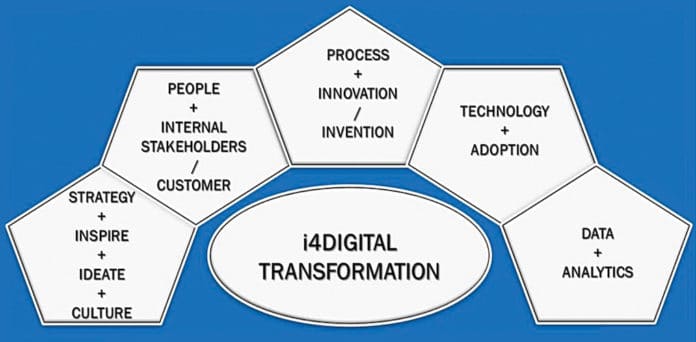While there are different methods to be adopted for a digital-savvy enterprise, how digital transformation can be used to develop a bankable innovation is discussed in this article.
During this challenging time of post-pandemic, in order to add value to their customers, the electronics industry needs to turn ‘smartest’ with accelerated digital transformation, which in today’s world is a must.
With the Internet of Things (IoT), cloud, artificial intelligence (AI), mobility, 5G, Wi-Fi 6 and Big Data analytics coming together, the end result is that ‘smart has to be smarter’ and ‘smarter has to be smartest’ while navigating through change management and achieving success by beating competition during this challenging time.
While there are many processes and technologies available to adopt and leverage, it is important to know which one is suitable to provide commercial value to organisations and customers.
According to a report by IDC, businesses are expected to spend 2.3 trillion dollars a year on digital transformation within the next four years, with worldwide digital transformation technology investment expected to hit at least 7.4 trillion dollars over the next four years.
Digital transformation avoids disruptions and helps cater to changing market and business needs for enterprises to stay ahead of the competition.
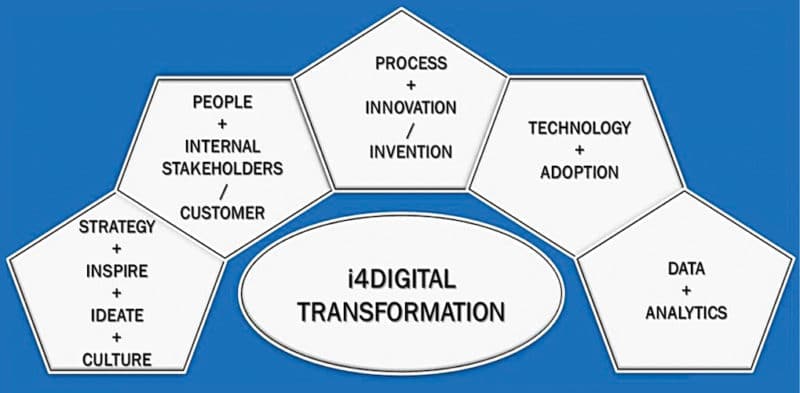
Digital transformation is a process used for integrating digital technology and leveraging various technologies involving cultural change, creating new business opportunities, enhancing customer experience, and increasing operational agility. It is very important to focus on the insights when digital transformation is adopted. In today’s era, the entire globe of digital transformation is driving three innovations—IoT, AI, and Big Data analytics.
IoT can be defined as digital transformation technology, or a set of technologies and components, enabling digital transformation. The biggest input IoT provides is tons and tons of data that needs to be managed and is a great fuel for digital transformation.
This article focuses on IoT and digital transformation with a touch of design thinking as this combination is highly successful in developing a bankable innovation.
Digital transformation for IoT
- IDC forecasts that worldwide spending on IoT is expected to reach one trillion dollars mark in 2022.
- New IDC report mentions that IoT spending in Asia/Pacific (excluding Japan) is expected to reach 398.6 billion dollars by 2023.
- Experts have predicted that people around the globe will have up to 75 billion IoT connected devices by 2025.
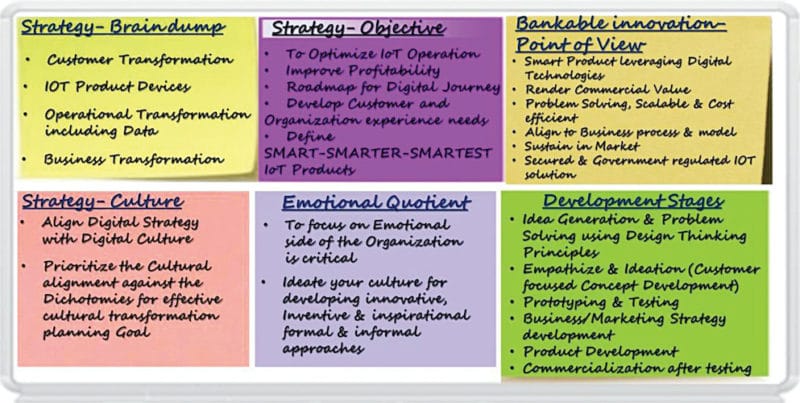
The queries to be answered are.
- With every company launching a new IoT product/service, will they succeed? If they focus only on technology, is it enough because they might struggle?
- Do they require a bankable innovation?
- Do they need to solve an existing problem first as IoT does not escape the basics of good product/service design?
While there are different methods to be adopted for a digital-savvy enterprise, how digital transformation can be used to develop a bankable innovation is discussed in this article.
While digital transformation is in itself a very big topic, in simple terms, it focuses on strategy, culture, people, process, technology, and data analytics.
1. Strategy to develop a bankable innovation
Strategic goals are the key to success in this digital era for the IoT Industry. It is important to get inspired and believe in the change by ideating. In order to develop a bankable innovation for digital transformation, it’s crucial to have senior leadership buy-in, prepare for a cultural change, and get inspired to believe in the innovation that has been developed. It is important to focus on the following strategy for the success of your digital journey:
- What do we want to achieve with this bankable innovation?
- Why do we need to transform?
- How can we transform?
- Do we have clear key performance indicators for innovation?
- Do we need to create a roadmap?
- Do we need to have SOP and review?
- How to make sure that all stakeholders have regular access to the information?
Customers need to adopt the right technology, enabling risk-free digital success with measurable ROI.

Based on multiple discussions, the team decides on the bankable innovation—a usable and valuable commercial opportunity to develop a device that can beat the competition and, at the same time, align to the organisation’s needs, customers’ needs, and market needs.
2. People to be leveraged for bankable innovation
This section discusses the people who need to:
- Be ready for change to develop a bankable innovation
- Understand the mission and vision of digital transformation
- Use proven industry principles like design thinking.
- Get motivated
- Be ready for behaviour change
- Get inspired to innovate and invent
- Include digital thinking in process
- Empower their team
It is always recommended to have a strong and aligned HR team to lead the people in the area of digital transformation. The HR team itself transforms by using digital technologies like automation. This transformed HR team sets an example for the rest of the organisation.
The team further develops balanced transformation teams as per the devised planning in strategising, developing, scaling, and marketing the bankable innovation. One of the critical areas in this section is brainstorming for the right skills and roles to develop the bankable innovation.
3. Process to be adopted for bankable innovation
To enhance productivity and successful digital transformation, it is important to list out processes or techniques that would be more efficient.
A process includes loading and execution of IoT task and checking outcomes upon completion of these tasks. Implementing these processes is the next step where there may be innovation and even invention involved.
To address complex digital transformation, several processes are required to develop a bankable innovation (refer Fig. 4).

While the above figure is only an example, digital transformation covers a huge number of processes, which include business processes (BP), BP optimisation, and BP automation. The process of sensor applications is discussed and defined.
Two examples: Smoke sensors are used in industrial IoT solutions to report even the slightest leakage or a minor occurrence of fire. Multiple sensors can monitor multiple pollution levels in the air or water in a connected city.
We all understand that these sensors/devices communicate with the cloud using the defined connectivity and perform an action by sending alerts, and whenever the critical levels are reached with data analysis over a period of time, exception handling processes are introduced.

4. Technology to be leveraged for bankable innovation
IoT technology stack connects physical and digital worlds, and the primary function is to collect data and process it. The device’s software includes operating systems and applications to process the data. Technology should support the IoT reference model that includes:
- Physical layer like devices and controllers
- Integration layer like connectivity, data element analysis, data storage, data processing, reporting, analytics, and control
- Business process layer that manages the business alignment
The combination of AI with IoT is an important focus area to discuss the bankable innovation for automation and control of devices.
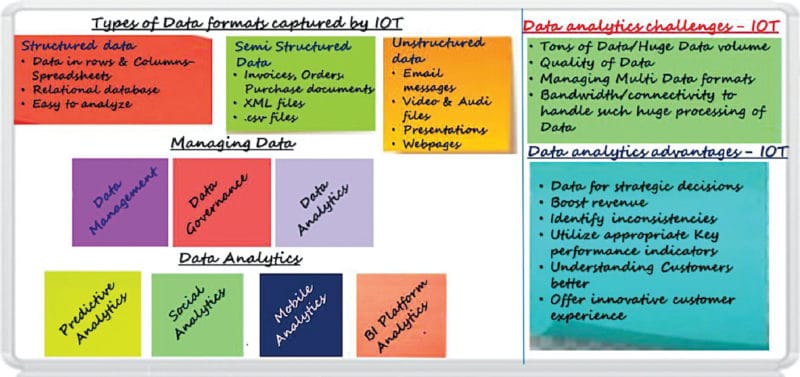
It is recommended that artificial intelligence of things (AIoT) should be used because when AI combines with IoT, a powerful bankable innovation can be developed for decision making or problem-solving. But risks need to be considered due to huge data from IoT and security reasons.
Another technology, IoT DaaS (IoT Big Data as a service), is growing nearly three times as fast as non-IoT DaaS. While cloud computing and IoT platforms are growing, edge computing and analytics are yet to be explored for maximum benefits.
5. Data analytics to improve productivity and make the right business decision for bankable innovation
We all know that IoT connected devices result in massive data that needs to be managed. Research shows that around 62 per cent organisations are using advanced analytics in new areas, 65 per cent organisations are using data from new sources, and 64 per cent organisations are using new analytics techniques.
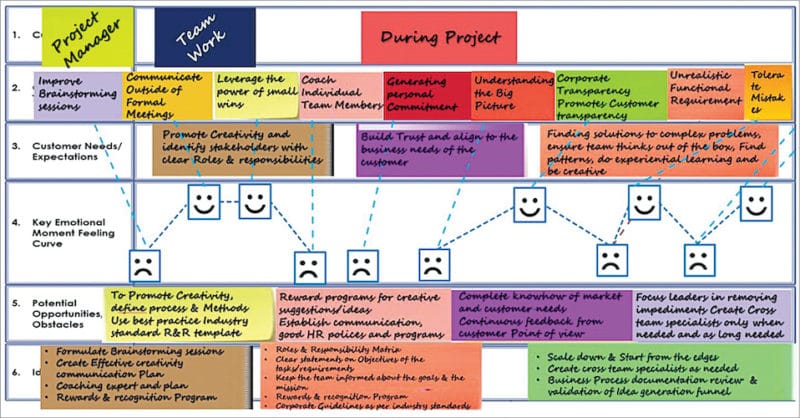
Eighty five per cent of the world data today is unstructured, and ninety per cent of the world data was created in the last three years.
The success of any IoT digital transformation depends on how efficient your systems are in capturing, organising, and maintaining analytics with huge terra bytes of data. The combination of AI with ML is being adopted by companies to achieve excellent customer experience with valuable business information to improve business decisions and enhance productivity.
It’s important to have an efficient and workable data analytics strategy to ensure that multi-structured, less reliable, merely processed, and real-time data is efficiently managed. It is also important to ensure that there is efficient data security as a recent study says that around 88 per cent of the companies conducting IoT Analytics see data security as an important challenge.
6. How to understand customers using customer journey mapping?
In order to solve one of the existing problems in IoT digital transformation, I would like to explain the methodology using the design thinking principle.
Design thinking can be explained as a human-centered collaborative design process with out-of-box solutions to unpack problems and successfully navigate to face disruption and re-envision the enterprises’ digital business journey.
There is an approach of brainstorming, brain dumping, brainwriting, brain walking, and recording the findings, as shown in Fig. 2 to Fig. 6.
In order to simplify the article, I have considered a problem statement for the digital transformation IoT use case, which is solved using some of the design thinking techniques.
7. Developing the right skills and successful teamwork for building bankable IoT innovation
In order to resolve the above problem, the project manager undergoes the process of:
Problem definition and mapping. Getting deep dive into the problem

Empathy. Getting into the shoes of the customer
Ideate. Brainstorming empathy findings and drawing a customer journey map
Customer journey map is used to visually represent the experience and emotions of customers at every step. We can tell the story of experience by looking into customer touchpoints, needs/expectations, emotional feelings, potential opportunities/obstacles, and finally listing ideas/solutions.
8. Value proposition for bankable innovation
The value developed by the IoT bankable innovation is the result of all the activities of strategy, people, process, technology and data analytics, wherein the problem to be solved is looked through design thinking, empathy, ideating, prototyping and testing with further business/marketing strategy development, product development, and commercialisation after testing in the market.
In conclusion, the above processes can be applied to all the use cases for any new or expandable innovations in IoT space.
Disclaimer. The views and content in this article are the author’s personal and based on some references.
Sreenath C. Lakshmanan is founder and CEO at i4DigitalValue



